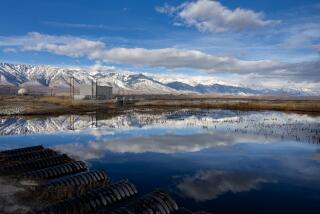Op-Ed: The Sierra Nevada snowpack will be 64% smaller by the end of this century. We need to prepare now
Although recent storms have dumped heavy snow across the Sierra Nevada, Monday’s snowpack measurement will almost certainly show that it is still well below average. Last week, the Sierra-wide reading put the total snowpack at 15.8 inches of water content, or 43% below normal.
Here’s an even more sobering reality. According to our new research, such spring snow measurements will be considered far above average in the decades to come.
We have just completed detailed projections of the Sierra Nevada’s future climate. Our findings tell the story of a snowpack on life support. If greenhouse gas emissions continue unchecked, by the end of this century, the Sierra snowpack in a typical April will be 64% smaller than it was at the end of the 20th century.
In simple terms: We’re going to lose a lot of snow to climate change. Equally worrisome, California’s water infrastructure is not resilient enough to make up for the loss.
Although the Sierra Nevada represent just a quarter of California’s land mass, they provide nearly two-thirds of the state’s fresh water in the average year. About half of that water comes in the form of rain, the other half as snow.
Our models show that there will be the same amount of overall precipitation in the future, possibly more. But global warming will cause a greater portion of it to arrive as rain instead of snow. It will also cause the snow that does fall to melt more quickly.
We’re going to lose a lot of snow to climate change. Equally worrisome, California’s water infrastructure is not resilient enough to make up for the loss.
Whereas rain runs off into rivers and reservoirs immediately, snow conveniently remains frozen until the spring thaw, when it melts and flows downstream well into summer. Historically, this is how California has dealt with the fact that our wet season — November to March — is not when our state uses the most water. We use the most water during the summer, when our crops and outdoor landscapes are thirstiest.
But springtime snow loss is just part of the story. We also assessed what the changes in runoff from rain and snowmelt will be throughout the year. By the end of this century, runoff will come in earlier, flashier spurts rather than the predictable spring and summer supply that water managers are used to. Storms that once resulted in big snow dumps will instead become heavy rain events. This will contribute to a significant shift in the timing of water flow into our dams and reservoirs. The midpoint of the annual runoff — when half the water that leaves the Sierra has done so — will get bumped up by 50 days on average, from May to March.
We won’t have to wait until the end of the century to see these effects. If there were no human-caused climate change, the snowpack during the recent drought would have been about one-third larger than it was. Under a business-as-usual scenario in which the world fails to act on climate change, the average April snowpack in the Sierra will be 30% smaller by mid-century.
The worst of the effects aren’t inevitable. Although significant global emissions cuts wouldn’t make much of a difference by mid-century, they could reduce end-of-century changes by half.
In either scenario, California’s water managers will face tough questions relatively soon. Among them: How can earlier, flashier water flows be captured so that wintertime floods are prevented? And given the limited space in our reservoirs, how can this water be stored so that it lasts through the dry season?
From our position in climate science, we can only relay the message that the research delivers to us. We can’t offer easy answers on the best policies or technological solutions. But we do have some suggestions for how they might be identified.
A sensible first step would be for California to undertake a comprehensive assessment of our current water infrastructure’s vulnerabilities to climate change. The state should also do cost-benefit and environmental-impact analyses for all possible options for replacing the storage capacity of the Sierra snowpack. We are doubtful that building new dams or raising the height of existing ones would make sense, for instance. Dams are expensive and cause environmental damage. It’s unclear that the storage gained would justify the costs.
Increasing groundwater storage is a more promising option. One idea is to divert Sierra storm water to open fields, where it can seep into groundwater aquifers. This would present many challenges, including potential issues around water rights, but underground storage could ultimately hold more water than new surface reservoirs.
Coastal communities could make better use of local water. In Los Angeles, most rainfall washes out to the ocean unused. Efficient rainwater capture, water recycling and conservation would lessen dependence on Sierra water and thus increase the city’s resilience to snowpack changes.
There are at least 23 million stakeholders in the Sierra Nevada’s water resources, and many of them don’t even realize where their water comes from. State leaders, city governments, water managers, agriculture, communities in the Sierra and Angelenos — we all need to participate in the critical discussion about how climate change will affect our water supply.
Alex Hall is a professor of atmospheric and oceanic sciences at UCLA and director of the university’s Center for Climate Science. Katharine Davis Reich is a science communicator and outreach director at the center.
Follow the Opinion section on Twitter @latimesopinion or Facebook
More to Read
A cure for the common opinion
Get thought-provoking perspectives with our weekly newsletter.
You may occasionally receive promotional content from the Los Angeles Times.










